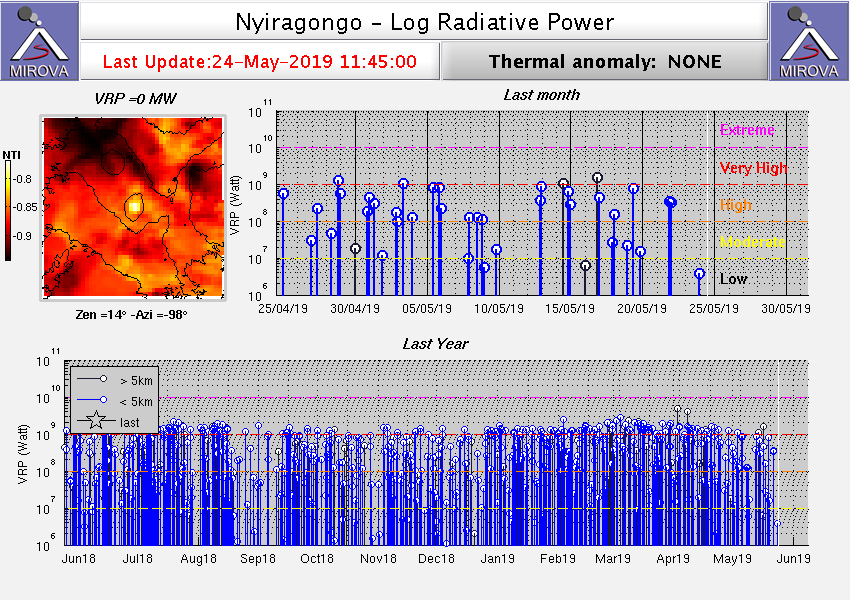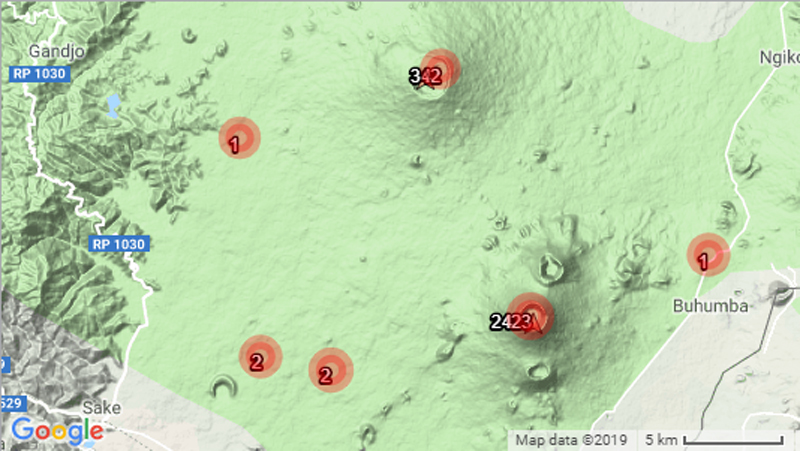Report on Nyiragongo (DR Congo) — May 2019
Bulletin of the Global Volcanism Network, vol. 44, no. 5 (May 2019)
Managing Editor: Edward Venzke.
Research and preparation by Kadie Bennis.
Nyiragongo (DR Congo) Lava lake remains active through May 2019; three new vents around the secondary cone
Please cite this report as:
Global Volcanism Program, 2019. Report on Nyiragongo (DR Congo) (Venzke, E., ed.). Bulletin of the Global Volcanism Network, 44:5. Smithsonian Institution. https://doi.org/10.5479/si.GVP.BGVN201905-223030
Nyiragongo
DR Congo
1.52°S, 29.25°E; summit elev. 3470 m
All times are local (unless otherwise noted)
Since at least 1971 scientists and tourists have observed a lava lake within the Nyiragongo summit crater. Lava flows have been a hazard in the past for the nearby city of Goma (15 km S). The previous report (BGVN 43:06) of activity between November 2017 and May 2018 described nearly daily record of thermal anomalies due to the active lava lake and lava fountaining, gas-and-steam plumes, and the opening of a new vent within the crater in February 2016. Monthly reports from the Observatoire Volcanologique de Goma (OVG) disseminate information regarding the volcano's activity. This report updates the activity during June 2018-May 2019.
OVG noted that the level of the lava lake changes frequently, and was lower when observed on October 2018, 12 April 2019, and 12 May 2019. According to data from the OVG, on 15 April 2019 the secondary cone that formed in February 2016 produced lava flows and ejecta. In addition, at least three other vents formed surrounding this secondary cone. During most of April 2019 the lava lake was still active; however, beginning on 12 April 2019, seismic and lava lake activity both declined.
MIROVA (Middle InfraRed Observation of Volcanic Activity) analysis of MODIS satellite data continues to show almost daily, strong thermal anomalies every month from June 2018 through 24 May 2019 (figure 66). Similarly, the MODVOLC algorithm reports a majority of the hotspot pixels (2,406) occurring within the lava lake at the summit crater (figure 67).
 |
Figure 66. Thermal anomalies at Nyiragongo for June 2018 through 24 May 2019 as recorded by the MIROVA system (Log Radiative Power) were frequent and strong. Courtesy of MIROVA. |
Geological Summary. The Nyiragongo stratovolcano contained a lava lake in its deep summit crater that was active for half a century before draining catastrophically through its outer flanks in 1977. The steep slopes contrast to the low profile of its neighboring shield volcano, Nyamuragira. Benches in the steep-walled, 1.2-km-wide summit crater mark levels of former lava lakes, which have been observed since the late-19th century. Two older stratovolcanoes, Baruta and Shaheru, are partially overlapped by Nyiragongo on the north and south. About 100 cones are located primarily along radial fissures south of Shaheru, east of the summit, and along a NE-SW zone extending as far as Lake Kivu. Many cones are buried by voluminous lava flows that extend long distances down the flanks, which is characterized by the eruption of foiditic rocks. The extremely fluid 1977 lava flows caused many fatalities, as did lava flows that inundated portions of the major city of Goma in January 2002.
Information Contacts: Observatoire Volcanologique de Goma (OVG), Goma, North Kivu, DR Congo (URL: https://www.facebook.com/Observatoire-Volcanologique-de-Goma-OVG-180016145663568/); Hawai'i Institute of Geophysics and Planetology (HIGP) - MODVOLC Thermal Alerts System, School of Ocean and Earth Science and Technology (SOEST), Univ. of Hawai'i, 2525 Correa Road, Honolulu, HI 96822, USA (URL: http://modis.higp.hawaii.edu/); MIROVA (Middle InfraRed Observation of Volcanic Activity), a collaborative project between the Universities of Turin and Florence (Italy) supported by the Centre for Volcanic Risk of the Italian Civil Protection Department (URL: http://www.mirovaweb.it/).


